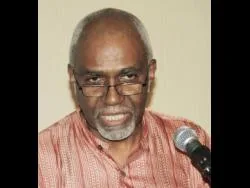
Salmon’s article, ‘Pragmatic reparations versus noise’, published in The Gleaner of August 31, calls for comment.
The article has misconceptions, some of which, concededly, may be due to the manner in which the Report on Reparations for Transatlantic Chattel Slavery (hereafter TCS) in the Americas and the Caribbean was presented when it was launched at the University of the West Indies on June 8. The report consists of three parts: The Introduction, Brattle’s Quantification of Reparations for Transatlantic Chattel Slavery (hereafter ‘Brattle’s Quantification’) and three Annexes.
It is to be recalled that, following the finding of an International Symposium that TCS was an unlawful practice, an Advisory Committee was established to resolve difficult issues relating to the assessment of reparations for TCS (Page 1 of the introduction).
The introduction is an integral part of the report; it is not a protocollary document; it is a substantive legal document, which provides important background information and sets out the decisions of the Advisory Committee relating to Brattle’s Quantification. Therefore, Brattle’s Quantification, important as it is, does not stand on its own. It is to be interpreted and applied in accordance with the Introduction.
The Introduction acknowledges that the reparation sums are high (Page 14). One reason for this is that the reparations were quantified over periods of hundreds of years at a specific rate of interest; moreover, reparations have never been paid, with the result that the quantification begins from the commission of the first wrongful act.
SHOULD NOT BE CHANGED
The Advisory Committee decided that the sums should not be changed for the reasons set out on pages 18 and 19 of the Introduction. The principal reason is that the Brattle Quantification is already an underestimation of the reparations that are due; consequently, a reduction was not warranted. Two of the factors accounting for the underestimation are that Brattle adopted a very conservative approach in its work, and a number of injuries and harms were not quantified because of lack of data.
The Advisory Committee concluded that the sums determined by Brattle reflected the enormity of the unlawful practice of TCS.
Nonetheless, the high sums are addressed in two ways, set out on pages 15 and 17 of the Introduction. First, there is a recommendation that states entitled to reparations should consider, in consultation with former slave holding states, the payment of reparations over a ten-year period, a fifteen-year period, a twenty-year period or a 25-year period, as set out in the three annexes to the report.
Second, the most consequential statement in the Introduction, in fact, in the entire report, including Brattle’s Quantification, is the following, also on pages 15 and 17: “It should be clarified that the sums set out in the [payment] schedules are only recommendatory, and that it remains within the sovereign will of a victim state to determine what sum, other than the compensation to which it is entitled (See tables 16, 17 and 22), it will accept as reparations.” This means that, although Brattle has quantified the reparations due from the UK in respect of Jamaica as US9.5 trillion dollars, it is open to Jamaica, after consultation with the UK, to accept any other sum as reparations. One would expect that in those consultations Brattle’s quantification would be taken into consideration.
CREDIBILITY
The report, therefore, does not, as the writer states, “market a trillion-dollar bill that must be paid”, and on that account could not be said to lack credibility.
Salmon complains that the UK is expected “to pay three times the sum of their economic output” as reparations. It should be noted, however that the figures are high only when applied to a country’s annual gross domestic product (GDP). Brattle argues that a better comparator is the cumulative GDP over the period of enslavement, and that when the cumulative GDP is applied, the estimated reparations to be paid by the United Kingdom are 13 per cent of that GDP. (page 83 of Brattle’s Quantification).
There is another matter raised in the article that warrants comment. It is the very difficult question of the position of persons who live in a responsible state, such as the United Kingdom, but are descendants of those who were enslaved in a victim state, such as Jamaica. This issue is mentioned on page 12 of the Introduction, which notes that the work of the Advisory Committee is confined to the Caribbean, Central America, South America and North America. Nonetheless, I am of the view that such persons are entitled to reparations for TCS, and I said as much in my address on August 23 at the Mayor of London’s celebration of Emancipation.
The position of those persons in the diaspora is an example of the complexity of the issues relating to reparations for TCS. We must be prepared to work as hard as is necessary for as long as it takes to execute the sacred trust left to us by our ancestors to ensure that reparations are paid for the grotesque wrong that was done to them.
Judge Patrick Robinson is a Jamaican member of the International Court of Justice. Send feedback to columns@gleanerjm.com.

